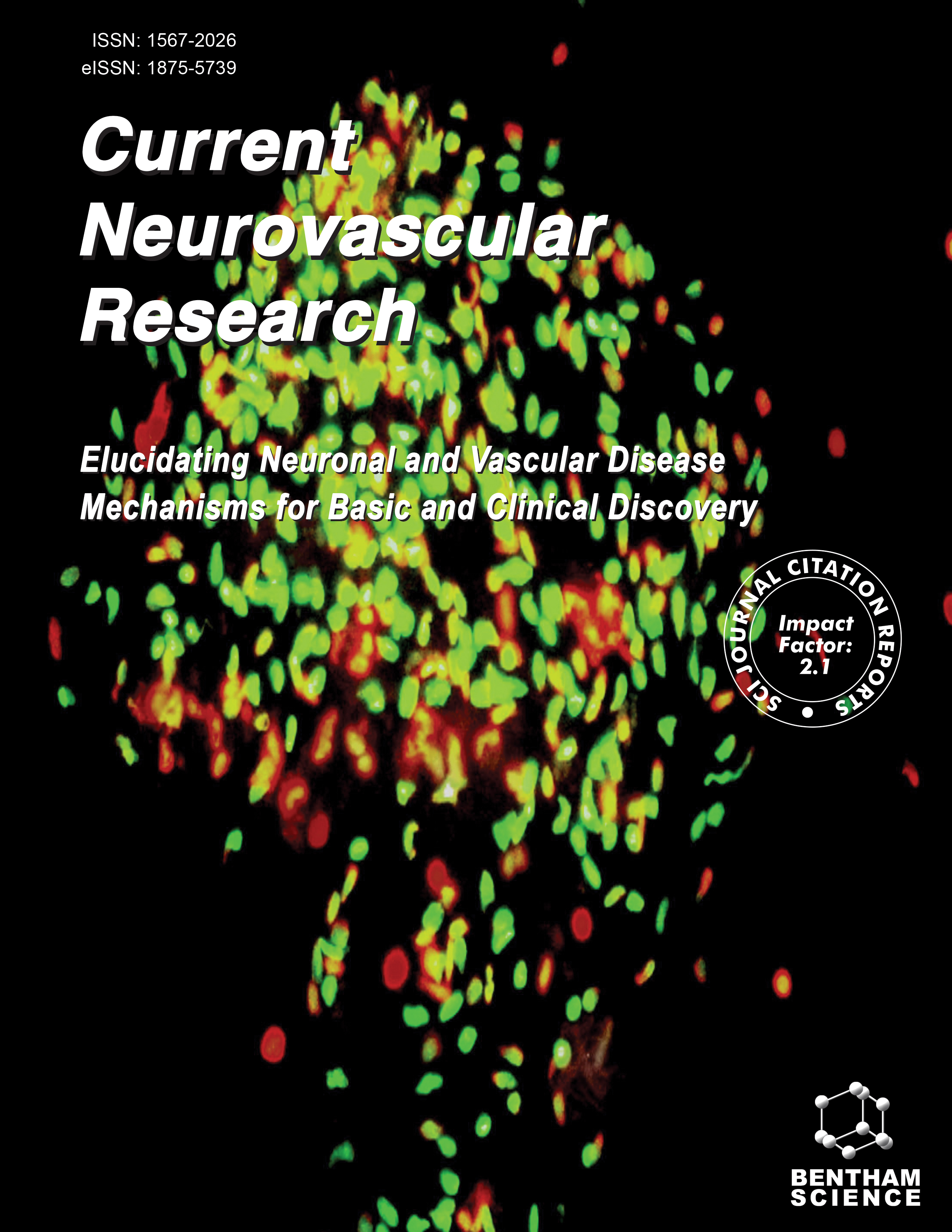- Home
- A-Z Publications
- Current Neurovascular Research
- Previous Issues
- Volume 2, Issue 5, 2005
Current Neurovascular Research - Volume 2, Issue 5, 2005
Volume 2, Issue 5, 2005
-
-
Timing is Everything
More LessAlthough it was initially Antoine Lavoisier who determined that oxygen is the only gas in air that sustains pulmonary respiration to prevent death and that almost 200 years later Barcroft introduced the terms "anoxic", "anemic", "histotoxic", and "stagnant" to designate the various forms of anoxia, our comprehension of human anoxic brain injury is far from complete. The term cerebral anoxia indicates any form of inadequa Read More
-
-
-
Aging Blunts Ischemic-Preconditioning-Induced Neuroprotection Following Transient Global Ischemia in Rats
More LessAuthors: Zhen He, Julia E. Crook, James F. Meschia, Thomas G. Brott, Dennis W. Dickson and Michael McKinneyThe present study examines the hypothesis that aging defined by the 50% survival age compromises neuroprotection afforded by ischemic preconditioning (IPC). Sixty-four male F344 rats aged 4- and 24-months, respectively, were subjected to IPC, (3-min ischemia) or sham-surgery followed by 10-min (full) ischemia or sham-surgery 2 days later. There were 4 groups at each age: sham-surgery-sham-surgery (SS), pr Read More
-
-
-
Hyperglycemia Potentiates Carbonyl Stress-Induced Apoptosis in Naive PC-12 Cells: Relationship to Cellular Redox and Activator Protease Factor-1 Expression
More LessAuthors: Masahiro Okouchi, Naotsuka Okayama and Tak Y. AwThe mechanism(s) of central nervous system complication associated with neurodegenerative disorders such as diabetes is unknown. Previous studies demonstrated that carbonyl stress induced by methylglyoxal (MG) mediates differential apoptosis of rat pheochromocytoma (PC12) cells in the naïve or differentiated transition states. Since chronic hyperglycemia is central to diabetic complications, and poorly differentiated c Read More
-
-
-
Erythropoietin Requires NF-κB and its Nuclear Translocation to Prevent Early and Late Apoptotic Neuronal Injury During β-Amyloid Toxicity
More LessAuthors: Zhao Z. Chong, Faqi Li and Kenneth MaieseNo longer considered exclusive for the function of the hematopoietic system, erythropoietin (EPO) is now considered as a viable agent to address central nervous system injury in a variety of cellular systems that involve neuronal, vascular, and inflammatory cells. Yet, it remains unclear whether the protective capacity of EPO may be effective for chronic neurodegenerative disorders such as Alzheimer's disease (AD) that Read More
-
-
-
Increased Behavioral and Histological Variability Arising From Changes in Cerebrovascular Anatomy of the Mongolian Gerbil
More LessAuthors: David T. Laidley, Frederick Colbourne and Dale CorbettThe Mongolian gerbil (Meriones unguiculatus) has been used extensively as a model of forebrain ischemia. Its unique susceptibility to ischemia was suggested to be due to an incomplete circle of Willis. The relative ease to which ischemia can be induced combined with highly reproducible delayed CA1 cell death following a 5 min occlusion made the model popular in neuroprotection studies. Presently, this assumption was t Read More
-
-
-
The Function and Integrity of the Neurovascular Unit Rests Upon the Integration of the Vascular and Inflammatory Cell Systems
More LessAuthors: Hyung S. Han and Kyoungho SukThe neurovascular unit is composed of a microvascular endothelium, neuron, and glial cell elements that are in physical proximity to the endothelium. The vascular system provides oxygen, glucose, and hormones for brain cells and guides the cells to appropriately respond to the local environment. Conversely, the brain cells, especially glial cells, can regulate the function of blood vessels in response to local requiremen Read More
-
-
-
Driving Cellular Plasticity and Survival Through the Signal Transduction Pathways of Metabotropic Glutamate Receptors
More LessAuthors: Kenneth Maiese, Zhao Z. Chong and Faqi LiMetabotropic glutamate receptors (mGluRs) share a common molecular morphology with other G protein- linked receptors, but there expression throughout the mammalian nervous system places these receptors as essential mediators not only for the initial development of an organism, but also for the vital determination of a cell's fate during many disorders in the nervous system that include amyotrophic lateral sclerosis, Pa Read More
-
-
-
The Emerging Role of Coenzyme Q-10 in Aging, Neurodegeneration, Cardiovascular Disease, Cancer and Diabetes Mellitus
More LessAuthors: Muralikrishnan Dhanasekaran and Jun RenCoenzyme Q (ubiquinone, 2-methyl-5,6-dimethoxy-1,4-benzoquinone), soluble natural fat quinine, is crucial to optimal biological function. The coenzyme Q molecule has amphipathic (biphasic) properties due to the hydrophilic benzoquinone ring and the lipophilic poly isoprenoid side-chain. The nomenclature of coenzyme Q-n is based on the amount of isoprenoid units attached to 6-position on the benzoquinone ring. It was Read More
-
Volumes & issues
-
Volume 21 (2024)
-
Volume 20 (2023)
-
Volume 19 (2022)
-
Volume 18 (2021)
-
Volume 17 (2020)
-
Volume 16 (2019)
-
Volume 15 (2018)
-
Volume 14 (2017)
-
Volume 13 (2016)
-
Volume 12 (2015)
-
Volume 11 (2014)
-
Volume 10 (2013)
-
Volume 9 (2012)
-
Volume 8 (2011)
-
Volume 7 (2010)
-
Volume 6 (2009)
-
Volume 5 (2008)
-
Volume 4 (2007)
-
Volume 3 (2006)
-
Volume 2 (2005)
-
Volume 1 (2004)
Most Read This Month
Article
content/journals/cnr
Journal
10
5
false
en


